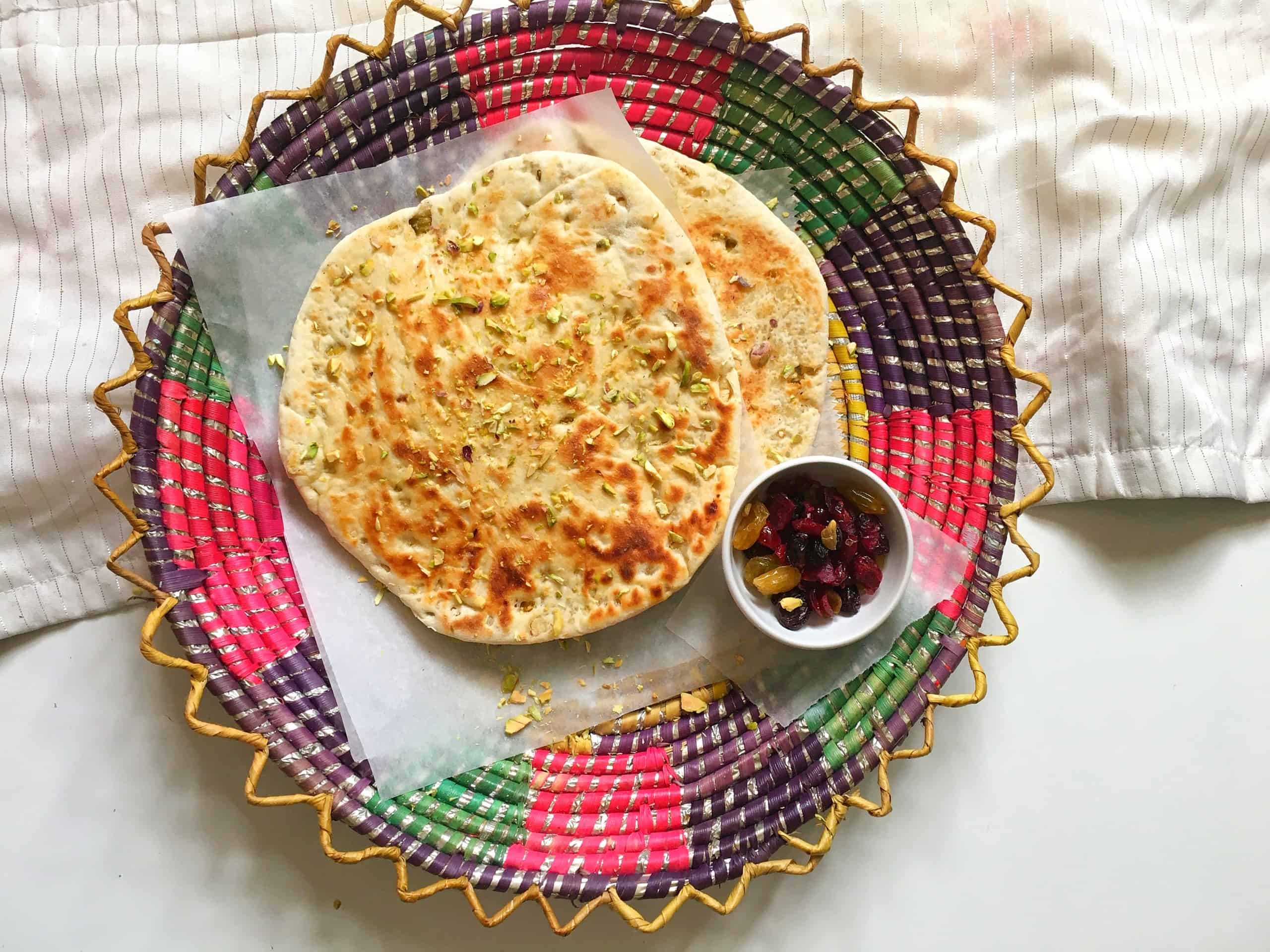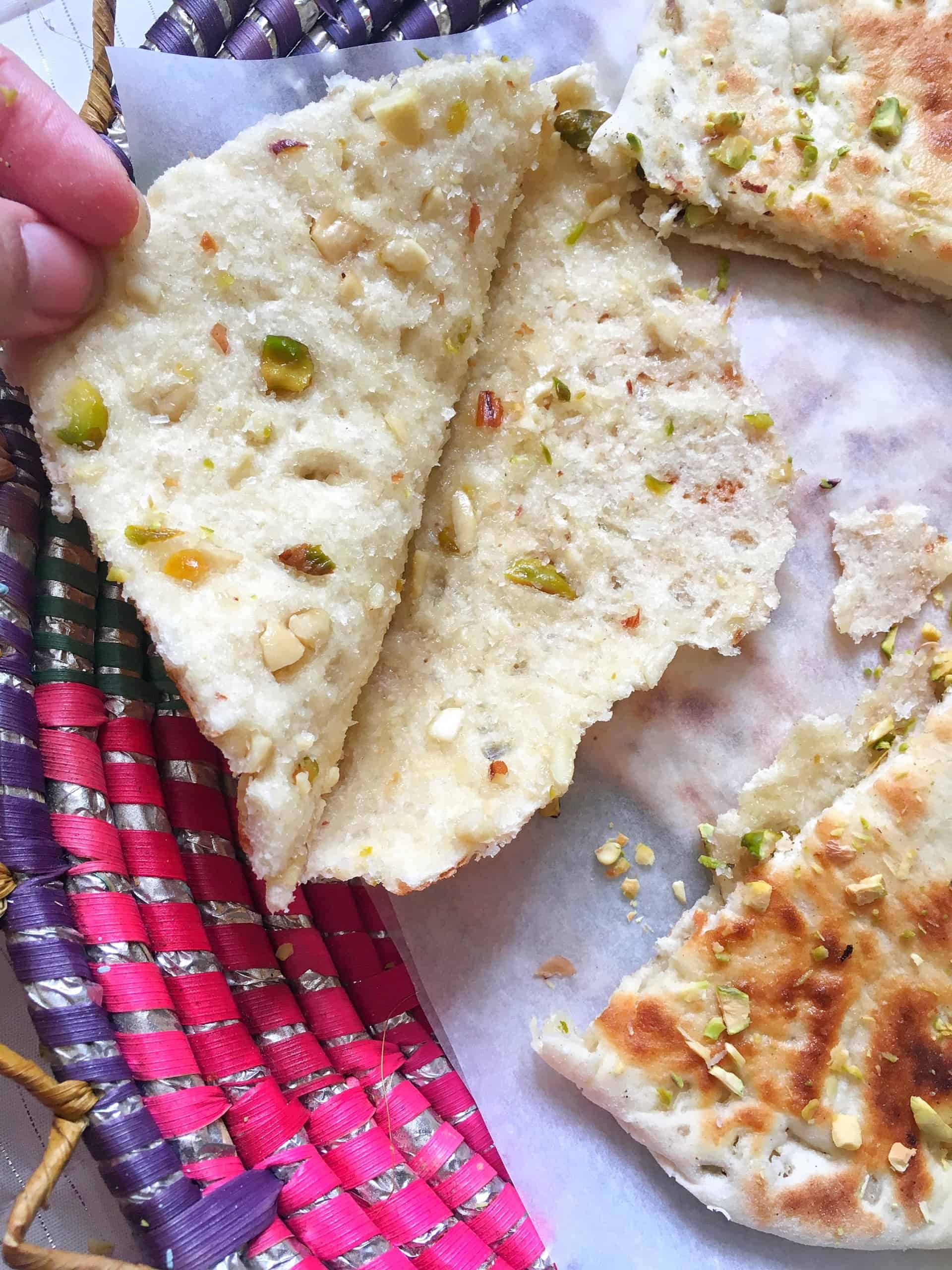I wasn’t aware of them until we accidentally ordered them as a side to our butter paneer and chicken korma whilst holidaying in the Isle of Skye back in 2018. I’m pretty sure my husband ordered them assuming we’d be getting a robust, large naan akin to the ones we get back home in London from all our local take outs. I don’t know about him, but that’s certainly what I was expecting. We both certainly were not expecting small, sweet coconut-stuffed naans garnished with raisins and pistachio nuts. I’d like to state here and now, those naans were delicious - but just not what we were expecting (or wanting!) at the time! It’s not too nice a sensation when your taste-buds are after savoury and they get sweet. It just hits a lil’ different when you aren’t expecting it, and not in a good way. I personally love the combination of sweet and savoury together (a’la Kabuli Pilau), but I just wasn’t sold after that first experience. Probably because I didn’t fully understand what it was. It was many months later, a non-Pakistani friend of mine asked me for the recipe for ’those really nice sweet naans you guys make’. I had no idea what she was talking about, so she sent me pictures. And that’s when it all clicked, and I realised… Peshwari Naans are an actual thing, and not the creation of confused Scots! A quick Google search confirmed this… and I suddenly realised I had been missing out on something amazing all my life. I experimented that exact same day (this was back in 2018, mind you) and pulled through with some delectably sweet, cushiony soft and oh-so indulgent Peshwari naans. I was hooked! How had I lived all my life not knowing about these? I posted them to my Instagram the first time I recreated them and have made these on occasion throughout the years. Spiked with just a hint of cardamom and cinnamon, this recipe is such a treat for a bit of chai-time action and so satisfying that you won’t even have to serve anything else alongside it!
🫓 What are Peshwari Naans?
Peshwari Naans are traditional naans cooked with a stuffing of sugar, coconut, nuts and dried fruit such as raisins. They are sweet, though they don’t necessarily have to be dessert-level sweet. My research drew inconclusive as to whether these have any true link to Peshawar (a city in Pakistan), as the name suggests, or whether these are exclusively a British-Indian takeaway thing. Whilst online sources and the name (obvs) does point out a link to Peshawar, friends on my Instagram informed me they have never seen these in their family or even in Peshawar. My conclusion from my research was quite simply: these are damn delicious and too good not to have up on the blog, so I think I can be forgiven if I don’t know where these are from… right?
🥣 How to cook Peshwari Naan at home
Good question. Traditionally, naans are baked in a tandoor oven, which is a super hot clay or metal oven used around South Asia. If you’re reading this blog, you likely don’t have access to a tandoor oven. (If you do, how lucky are you!?) Fret not, we can still cook naan at home. The two most common options (probably your only options tbh) are to cook it on either the hob stove, much like you’d cook roti, or to bake it in a super hot oven. I explain both methods in more detail furtherin the post. The naans you can see in the pictures in this post were cooked on the stove. I cooked my Keema Naans in the oven and you can probably notice the difference in the colouring. It’s totally up to you which you prefer. As a personal preference, I prefer the oven.
📃 Method
This method is divided into four parts: making the naan dough, making the sweet filling, rolling out, and finally cooking the naan.
Part 1: Make the naan dough
This naan dough is my go-to naan base used in my Keema Naan and Roghni Naan recipes. It involves allowing yeast the bloom in some warm milk, before adding in sugar, egg, yogurt and flour. The naan dough will need some time to rise before we can use it - about 1-2hrs in a warm place will do the trick. Whilst we’re waiting, we can start on the filling.
Part 2: Make the filling
Simple as it gets. Gather together the ingredients for the filling: desiccated coconut, sugar, finely chopped nuts, dried fruit and optional cinnamon and cardamom powder. Mix everything together alongside some unsalted butter, and set this aside to use later. You can choose whichever nuts you have to hand, or prefer. Almonds, cashews, hazelnuts, even sesame seeds, work great here! For dried fruit, the go-to option is raisins or sultanas, but you can also consider chopped apricots or prunes, just so long as they’re chopped up finely.
Part 3: rolling out the naan
The process of rolling the naans out is very much similar to if you were rolling out a stuffed paratha. My preferred way is first divide the dough into equal parts - this recipe will make 8. Once divided, take one dough ball and roll it out on a floured surface using a rolling pin. It doesn’t need to be round at this stage. Scoop in about 3-4 tablespoon of filling into the centre. Then, pretending the naan is a circle (well, it is), bring in the top and the bottom of the circle to meet in the centre, and then pinch well to bind. Below is a visual to help you understand what I mean by this. Then, do the same for the left and right sides of the naan circle. You’ll end up with the image below on the left - with 4 corners just hanging out. You want to bring these in to the centre too, pinching together the corners across each other into the centre. Push everything down with a firm hand, to securely encase the filling in the naan. Now, you can roll out the naan once again - this time very gently. Holes will be inevitably, since we’re dealing with nuts and raisins in the filling - but do try your best to avoid gaping holes or large rips. A well floured surface, a gentle and slow hand, and some pressure using your hands to evenly disperse the filling if needs must, will do you good here.
Part 4: Cooking the naan
At this stage, you have 2 cooking options: on the stove, or in the oven.
To cook in the oven:
Place the naans into an oven preheated at 200 degrees Celsius. Allow this to cook for 7-8 minutes, or until you see gold spots appear on the surface of the naan. You don’t need to flip the naan over during this time.
To cook on the stove:
Preheat a crepe pan/tava on a medium-high heat. Once hot, place on the naan. Cook on one side for 2-3 minutes, then flip over using a spatula. Cook on the other side for 2 or so minutes, and then flip again if needed until the naan dough is cooked through. ⭐ With both methods, brush the naan over with some unsalted butter or ghee before setting in a warm, covered place (e.g., a hot pot, or a clean tea-towel) whilst you prepare the rest of the naan.
🍽️ Storing and reheating
Peshwari Naan is ideally eaten immediately. When it cools, the sugar in the filling solidifies, and the naan can become stiff. You can negate this stiffness by using self-raising flour instead of plain flour, and brushing the naan with ghee after cooking - however, it still won’t be as soft and fluffy as fresh off the hob/oven. If you must prepare these in advance, I would advise cooking them till completely done, and then storing them in a hot pot or very will insulated, airtight container, so they retain their moisture and softness. When you need to warm them up, do so on a pan or in the oven for a few minutes, until warmed through. Alternatively, a whizz in the microwave for 46-60 seconds should warm it up well (times will vary based on your microwave). Store at room temperature, to avoid stiff Peshwari Naan syndrome. For this reason, I wouldn’t advise on keeping these in the fridge, or freezing them.
⭐ Tips for Your Peshwari Naan
The measurements for the stuffing are super forgiving, honestly. The measurements I have provided are for a mild, not overwhelming level of sweetness. You can totally play around with the measurements to adjust the flavour to your liking. Be prepared to generally play around with the quantity of filling you prefer for the naan too. Use the following recipe as a starting point - you may find you prefer more filling or maybe even less. Please double check to ensure the nuts you use aren’t salted, as that really impacts the overall flavour, and not in a good way.
For a modern twist, try adding some chocolate chips! The dried fruit are optional. That’s what I’ve done in the images shown. You can garnish these with icing sugar, chopped nuts, more coconut - you can really get creative!
Enjoy, with love x
📋 Recipe
Enter your email & I’ll send it right over. Plus, you’ll get bonus Pakistani food-goodness from Fatima Cooks, like new recipe alerts, exclusive email-only recipes + more! By submitting this form, you consent to receive emails from me. Your details are secure. Opt-out any time.












